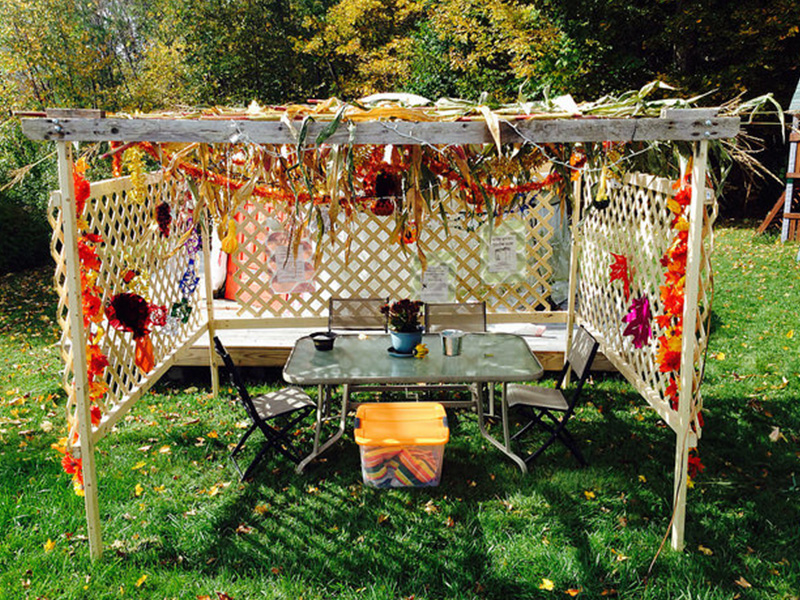Last time we looked at where to get advice if you’d like to build your own sukkah. The tips and plans were sound but perhaps a bit square. Today, we look outside the box.
You say that you don’t have room for sukkah? No problem if you have access to a pick-up truck (or a camel). The Mishnah explains that a sukkah built on top of a wagon or on the deck of a ship may be used on the holiday. Chabad Sukkah-mobiles are familiar sights in many communities around the world and they’re kosher (of course).
And a sukkah built on a treetop or the back of a camel is valid but may only be used on the intermediary days of the holiday (but not Shabbat). Impossible you say? Then you haven’t been to Israel’s Neot Kedumim Biblical Reserve where each year, they construct the wild sukkahs described in the Mishnah.
Strange Sukkahs!
Why settle for a Sukkah that has three or four rectangular walls, when you can build ones that are shaped like a “polyhedron with eight triangular faces”? Without a doubt, the plans for the most unique sukkah that I came across online is for KOSHO, an entry in New York’s 2010 Sukkah City Competition.
Imagine massive triangular walls, each one of which has several planks fanning out from one corner to the opposite base. After assembling these triangles, you can download plans to create a structure which when viewed from above takes on the shape of a Star of David. Although the shape is unorthodox, a note on the site explains that KOSHO is kosher and meets halachic requirements.
For more inspiration and wild designs, take a look at the shots some proud sukkah builders have shared on Pinterest. I particularly like the one made of Clics (like super-sized Lego.) Colourful and kosher too!
Sukkah City Competition (documentary preview)
For anyone who is thinking of taking the easy way out and buying a pre-fab sukkah, read up on the trials and tribulations of Ellis Shuman: “Two hours of sweat and anger later, the construction of my new sukkah had collapsed on the heads of my family, who had all been enlisted in the unsuccessful task of erecting our simple sukkah.”
“’I want my money back,’ I demanded on the phone to the salesman the next day. ‘But it’s so simple. Didn’t you follow the instructions?’ he retorted. ‘What instructions?’ I shouted.” Don’t worry, things end happily for Ellis and his family.
Although the walls may get most of the attention, what happens on top will make a huge difference determining whether your sukkah is kosher or not. There are a multitude of rules governing the covering or “schach.” But once you have followed the basic requirements, the sky’s the limit: unfinished wood slats, corn stalks, palm branches, evergreen branches are all fine. The Star-K site provides details.
If you are thinking of erecting a sukkah in an apartment, a condo or some other shared space, explaining what you are about to do and how it is temporary can go a long way to calm neighbours who may be irritated or just plain puzzled by your handiwork.
There are numerous cases of condo boards or even cities who have attempted to restrict the right to erect sukkahs. For example, the attorney for a Bal Harbor, Florida, condominium wrote that allowing the construction of a sukkah is “tantamount to a Christian making an altar by the pool during Lent.” Other battles of the booths have taken place in New York , Outremont and even Tel Aviv.
Do You Want to Build The Sukkah? [Disney’s Frozen parody]
But perhaps the most interesting fight was the one which had to be settled by the Supreme Court of Canada. A condo board in Montreal had opposed the construction of sukkahs on residents’ balconies and offered to allow them in the condominium’s common square. But the residents insisted they wanted the sukkah on their balconies. So they went to court and lost all the way up to the Supreme Court. The Supreme Court eventually (and narrowly) ruled in their favour “for the potential annoyance caused by a few sukkahs being set up for a period of nine days [including one day to set up the sukkah] each year would undoubtedly be quite trivial.”
With all these potential challenges, is building a sukkah really worth the effort? It certainly is for Edmon J. Rodman. “Building a sukkah allows your mind to wander to another time and place. … All this measuring, cutting and hammering also reminds us that we are builders, and recalls an earlier time when the tasks of creating from scratch was on our collective minds. In 1930s Palestine, a popular chalutz folk song by Menashe Ravinah had the line ‘Anu banu artza livnot u’lehibanot ba’ — ‘We have come to this land to build it and to be built by it.’”
“This year as you lay out the materials and tools, as you define the space that will define your season of joy, think about this: As you build the sukkah, is the sukkah building you?”
